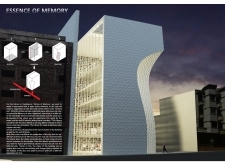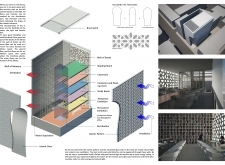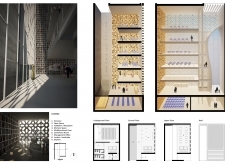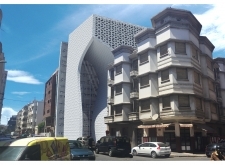5 key facts about this project
### Overview
The "Essence of Memory" library is located in Casablanca, Morocco, strategically designed to engage with the region's socio-cultural and historical narrative. This facility acts as a repository for knowledge while also serving as a space for public reflection, commemorating significant events in Moroccan history. The project emphasizes the dual role of the library—functioning both as a community resource and a monument of remembrance.
### Spatial Organization and User Experience
The library's design thoughtfully separates the functions of memory and engagement through a distinct spatial division. The western section is dedicated to the reflective aspect, marked by the "Wall of Memory," which features inscriptions of important historical dates and events. In contrast, the eastern section operates as a traditional library, offering multi-functional spaces for reading, studying, and exhibitions. This layout allows users to traverse between areas of contemplation and interaction, fostering a dynamic experience as well as ensuring accessibility throughout.
### Materiality and Sustainability
The exterior of the library employs a blend of concrete, glass, and textured panels, conveying durability and cultural resonance. The façade's geometric lattice, inspired by traditional Islamic design, enhances light control and ventilation while contributing to the building's aesthetic quality. Roof-mounted photovoltaic cells underscore a commitment to sustainability by harnessing solar energy. Additionally, the design incorporates natural ventilation strategies to maintain comfortable interior conditions year-round, highlighting an integrated approach to environmental stewardship.






















































